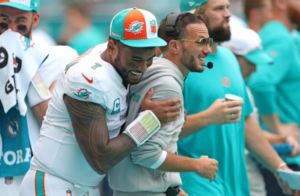
A week into its inaugural season, the AAF received multi-million dollar investment to stay afloat, but that shouldn’t be a cause for concern, especially as ratings continue to rise
The Alliance of American Football (or the AAF) received a $250 million investment from the majority owner of the Carolina Hurricanes, Tom Dundon earlier last week, which essentially bought him a spot as the League’s new chairman. While there has been speculation as to who published reports that the League was hemorrhaging money and why, Dundon specializes in financial services and entertainment, and has a majority stake in Topgolf on his resume. Dundon became an investor in Topgolf in 2011, and since then, the company has seen triple-digit growth proving that with the right people, a market can be tapped and created.
One of the biggest issues startup football leagues face is whether the proof of concept would be viable, especially with long-term growth. Throughout the AFF’s inaugural season, questions about whether fan interest would stall out around the NCAA tournament or NFL Draft schedule have also been raised. However, the AAF has already proven that it’s not a gimmicky league. You aren’t going to see sub-par, out-of-shape guys shotgunning beers in the endzone of a short field, and you aren’t going to see guys who think they’re entitled.
One of the biggest competitors the AAF will face is likely to be the XFL, which is set to kick off in 2020 with eight teams in Dallas, Houston, Los Angeles, New York, St. Louis, Seattle, Tampa Bay, and Washington D.C. The XFL is very much still in “startup” mode, meaning that coaching hires are still being made, as well as upper-level positions. There are several business aspects that will create direct competition between the XFL and the AAF. Both leagues will begin play right after the NFL wraps the Super Bowl, and players have the opportunity to leave their leagues and join NFL rosters if opportunities present themselves.
Beyond those opportunities, however, is a League that is already ensuring that scaling and player wellness is being measured through data analytics. For a League that has seen viewership numbers that have been greater than the NBA, which is precisely how the AAF is designed to determine growth, unlike its competitors who rely on ticket sales. For the AAF, analytics from gambling is boosting its commitment to technology that other leagues have weary of for decades due to gambling having a reputation for tarnishing leagues, corrupting outcomes, and overall bad publicity. However, according to Charlie Ebersol–the co-founder of the AAF–in today’s world, money from ticket sales and traditional revenue streams are pocket change compared to the “back-end technology and how it can be sold to other partners.”
With the AAF serving as somewhat of a developmental league to the NFL that features former big-time players, the interest is already built-in, and investors’ confidence is so high in the product that investors which include MGM are investing upwards of $750 million into the technology that is propelling the League. With software engineers from Tesla and Lockheed Martin spearheading the development, technology that lets fans predict plays and interact in real-time is creating a new niche that feels more like a virtual reality game, as opposed to traditional fantasy football, which is driven by previously collected data, as opposed to real-time analytics. Players will participate in the data gathering process by wearing technology in games that will help automate player performance in real time.
As ratings continue to rise for the third straight week, it’s becoming easier to defend the League and its proof of concept. Games are averaging just under 500,000 viewers-per-week, and what’s more, fans are noticing that rules are significantly more “flow friendly,” which has been a serious problem in recent years, especially with defensive penalties growing yearly.
The AAF is motivated by fans and technology, as opposed to the NFL, which is led by billionaires who’s biggest critique is how disconnected owners are to the viewers and their needs, wants, and frustrations. Perhaps, as the AAF’s investor pool continues to grow, viability will continue to strengthen and fans will continue to allow themselves to become more and more invested in the League. But for now, as technology and data continue to drive this, it’s important to remember that active participation by fans (not just viewership) is critical in the AAF’s sustainability function.







No comment yet, add your voice below!